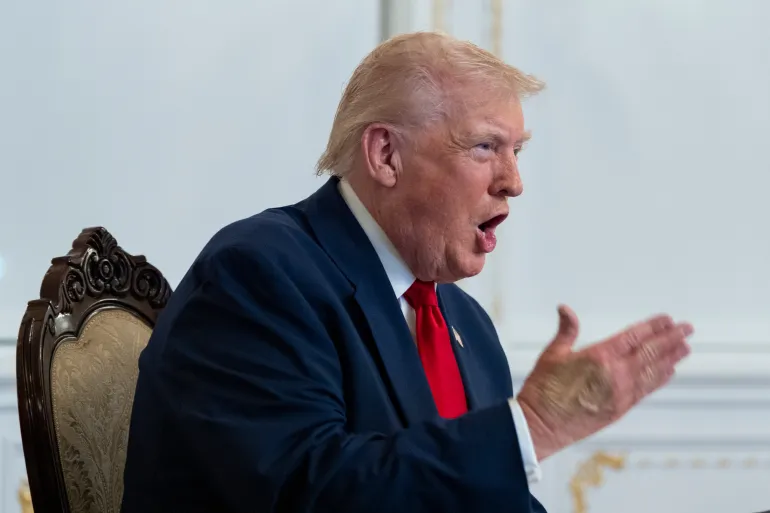Bloomberg, the New York Times, Reuters, CNBC, BBC, the Financial Times, and the Hill contributed to this report.
America’s trade showdown with China just opened a new front: the waterfront. Starting Tuesday, the US began charging special fees on Chinese ships that call at American ports — and on any foreign carrier that shows up in a Chinese-built vessel. The goal, according to the administration, is twofold: push back on Beijing’s dominance in commercial shipbuilding and nudge business toward a long-dormant US industry.
China punched back almost immediately. Beijing’s Ministry of Transport rolled out mirror fees on US-linked vessels — owned, operated, flagged, or built in the States — and warned more retaliation could follow. It’s all landing as broader tensions spike: China just tightened controls on rare earths, President Trump floated another round of triple-digit tariffs before softening the tone, and both sides are trying (and struggling) to keep a dialogue alive.
Supporters of the US move argue Beijing turbocharged its shipyards with subsidies, letting China corner a massive slice of the global market. The numbers are stark: by 2024, Chinese yards were delivering roughly 60% of the world’s large commercial vessels, up from 44% five years earlier. The US, by contrast, managed to launch…one. With US-built ships sometimes costing up to five times more than Asian rivals, Washington is betting port fees can make Chinese hulls less attractive and start to rebalance the playing field.
The fees stem from a trade investigation opened under the Biden administration and finalized this year. They’re targeted first at Chinese shipping companies (which can’t avoid them), and then at the non-Chinese lines that have snapped up scores of Chinese-built ships. Those carriers are already shuffling their fleets to keep Chinese tonnage away from US routes and limit the hit.
Analysts say China’s state-backed COSCO could be on the hook for eye-watering sums — as much as $1.5 billion next year by one bank’s estimate — a blow that could slice deep into operating profits. But it’s not just Chinese brands in the blast radius. MSC, the Swiss giant that ordered a dozen large container ships from Chinese yards this year, faces logistical headaches (and potential costs) if it wants to keep those vessels out of US service.
On the American side, the measures dovetail with a push in Congress to seed a shipbuilding revival via subsidies and industrial policy. There are green shoots: South Korea’s Hanwha bought Philadelphia’s legacy yard and placed a 10-ship tanker order there. Still, skeptics say fees alone won’t spur a rush of orders for complex US-built carriers; timelines and costs remain daunting.
Beijing’s response is broader than copy-paste port charges. It sanctioned five US subsidiaries of Hanwha Ocean, accusing them of “assisting” Washington’s probe and policies against Chinese shipping and shipbuilding. Hanwha’s shares slumped on the news, and Beijing hinted more targets could follow. China also clarified that Chinese-built ships would be exempt from its new levies — a not-so-subtle incentive for global lines to keep buying from its yards.
Shipping lines insist they won’t jack up rates immediately. But supply chains hate inefficiency, and workarounds aren’t free. Rerouting fleets to dodge fees can mean longer voyages, suboptimal capacity, and higher operating costs. Trade economists warn those pressures tend to seep into freight rates over time — and from there into the price of everything from furniture to fuel.
There are carve-outs and caveats. After pushback from energy and industrial lobbies, Washington softened some rules tied to foreign-built LNG carriers and granted temporary relief for certain long-term charters. Even so, analysts estimate a meaningful share of crude tankers, LPG carriers, and container ships worldwide will still get caught by one side’s fees or the other.
This isn’t just another tariff spat. It’s industrial policy by port invoice — an attempt to “de-risk” critical maritime capacity and steer future orders away from Chinese yards. Whether it jump-starts US shipbuilding is an open question. For now, the most immediate impact is on fleet deployment decisions made in shipping boardrooms, not welding torches firing up in American yards.
What to watch next
Fleet reshuffles: How aggressively do carriers redeploy Chinese-built ships off US routes — and at what cost?
Congressional sweeteners: Does shipyard subsidy legislation advance, and how generous does it get?
Tit-for-tat escalation: Do China’s sanctions spread beyond Hanwha, and does Washington tighten the screws further?
Rate pass-through: If fees persist into peak seasons, watch freight rates and spot surcharges for signs of drift higher.
Rare earths linkage: Beijing’s export controls on critical minerals are already in play; expect cross-pressure between the minerals and maritime tracks of the dispute.
The world’s busiest sea lanes just got a new toll booth — two of them, in fact. Even if both sides cool the rhetoric, the cost calculus for global shipping has changed. The question isn’t whether the charges matter, but how quickly they ripple from docks to balance sheets — and eventually, to shoppers’ receipts.










The latest news in your social feeds
Subscribe to our social media platforms to stay tuned